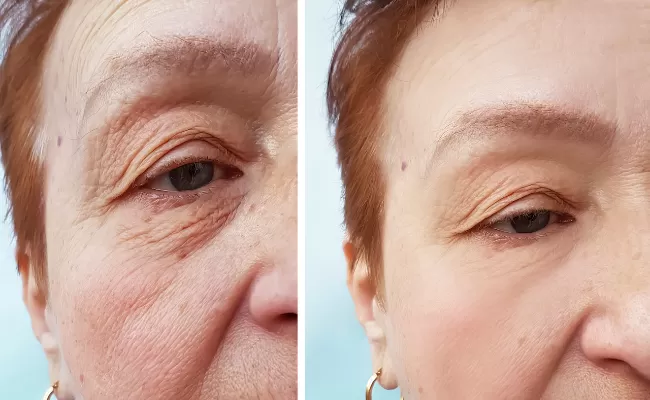Follow Us on Social media
Eyelid Surgery or Blepharoplasty
A surgical treatment called blepharoplasty can enhance the appearance of your eyelids. It lifts the skin that hangs down from your upper lids and lessens the appearance of fatigue in your lower lids. There are hazards associated with surgery, even though it is usually safe. Discuss the advantages and disadvantages of the procedure with a board-certified ophthalmologist.
What is blepharoplasty?
The area surrounding your eyes can look better with blepharoplasty or eyelid surgery. This surgery eliminates extra skin from your upper eyelids and lessens bagginess from your lower eyelids. Skin gradually loses its suppleness with age. Excess skin gathers in the lower and upper eyelids due to gravity's constant pull and your lack of suppleness. You can have blepharoplasty on your lower eyelids, upper eyelids, or both.
Extra skin, muscle, and underlying fatty tissue are frequently removed during a blepharoplasty. However, in rare cases, medical professionals can move tissues instead of eliminating them. Although blepharoplasty is essentially a cosmetic operation, it can also help those whose sagging upper eyelids are obstructing their field of vision.
With blepharoplasty and fat excision, Crow's feet, facial wrinkles, and dark circles under the eyes cannot be removed. Dark circles can be lessened with additional surgical and nonsurgical procedures that raise your cheekbones, fill in the hollows under your eyes, or realign fat. Physicians can do blepharoplasty alongside face surgery procedures, like brow lifts or laser resurfacing.
Who is a good candidate for blepharoplasty (eyelid surgery)?
Those at least thirty years old, in good health, and without any other eye disorders are typically the ideal candidates for blepharoplasty surgery. Inform your medical professional if you suffer from any of the following ailments:
• Eye conditions such as detached retinas, dry eyes, and glaucoma.
• Thyroid conditions such as hyperthyroidism, hypothyroidism, and Graves' disease.
• Circulatory problems, excessive blood pressure, or cardiovascular disease.
• Diabetes.
Regarding your aspirations regarding blepharoplasty, be reasonable. You might feel more confident and look better with eyelid surgery. However, you shouldn't anticipate a significant change in appearance following surgery. Many people have eyes that are of various sizes or that are not precisely aligned. Early in the developmental process, asymmetrical traits appear. Your facial structure won't change after a blepharoplasty. Knowing your face well is crucial before deciding to have surgery. Consider your expectations carefully and share them with your surgeon.
How should the patient get ready for surgery on their eyelids?
Your oculoplastic surgeon or ophthalmologist may require you to do the following to get ready for a blepharoplasty procedure:
• Have lab work or a medical evaluation completed.
• Give up smoking.
• Modify the drugs you use now or begin taking certain ones.
• Aspirin, blood thinners, multivitamins, herbal supplements, and anti-inflammatory medications should all be avoided as they raise the risk of bleeding.
blepharoplasty procedure
Your surgeon's recommendation and your desired outcome will determine whether blepharoplasty is performed on your lower eyelids, upper eyelids, or both.
Upper Blepharoplasty
During an upper blepharoplasty, your surgeon will create incisions in the natural crease of your top eyelid. As long as your eyes are open, these incisions will remain hidden. After removing any extra skin and fat that protrudes, your surgeon will close the incisions.
Lower blepharoplasty
Your surgeon will create an incision slightly below your lower lash line to perform a lower blepharoplasty. With this incision, they will remove extra skin from your lower eyelid. To address problems with your lower eyelid and remove or redistribute excess fat, they might also perform a transconjunctival incision, a covert incision made inside your lower eyelid.
What is the duration of a blepharoplasty procedure?
An upper blepharoplasty can usually be finished by a surgeon in 45 to 1 hour. Whether the upper and lower eyelids are done simultaneously, the procedure takes roughly two hours, depending on whether more work needs to be done or whether fat needs to be moved.
after blepharoplasty procedure
Your upper lids will be stitched, and the stitches should last for around a week. If the cuts are made on the inside of your lids, there is no need for stitches in the lower lids. Both your lower and upper lids may swell and bruise often. After surgery, plan on staying home from work and limiting your activities for a few days to give your eyelids time to heal.
Risks and Benefits of blepharoplasty
Are there potential side effects from eyelid surgery or blepharoplasty?
Like any surgical operation, there is some risk involved. Although they are uncommon, blepharoplasty complications and poor outcomes do occasionally happen. Issues that may arise consist of:
• Losing blood.
• Contamination.
• Ocular dryness.
• An unusual change in the color of your eyelids.
• Disfigurement.
• Unusual creases in or out of the skin around your eyes.
• The incapacity to shut your eyes completely.
• A lower lid lash line that is drawn down.
• A potential visual loss.
Before you choose to have the procedure, it's crucial to be aware of any potential consequences, no matter how uncommon they may be. The majority of patients are satisfied with their outcomes after blepharoplasty.
the blepharoplasty recovery time
Even though the procedure is usually painless, you might bruise and swell a little. After ten to fourteen days, most people feel comfortable going out in public. However, it may take several months for a full recovery.
You can reduce edema after your blepharoplasty using cold compresses and antibiotic ointment. Your surgeon will provide you with detailed instructions, which could consist of:
• How to maintain your eye health.
• Drugs that promote healing and lower the risk of infection.
• Particular issues to be aware of at the surgery site.
• The ideal time to see your surgeon again.
How long does a blepharoplasty last?
Aging of the eyes cannot be stopped by blepharoplasty. However, the effects are typically long-lasting. While lower eyelid surgery never requires repeat procedures, upper eyelid surgery can last anywhere from five to seven years to a lifetime.
When should I call my doctor or my healthcare provider?
After surgery, dry eyes can happen to some people, but it seldom lasts more than two weeks. Contact your healthcare practitioner if your dry eyes persist for over two weeks.
How painful is blepharoplasty surgery?
One of the least painful cosmetic surgeries is blepharoplasty. On the day of the procedure, you might experience some mild discomfort, but you should rapidly recover.
What is the best age to have blepharoplasty?
Anybody over eighteen can get surgery on their eyelids. But healthy adults thirty years of age and older make the ideal prospects. According to the American Society of Plastic Surgeons, most patients are older than 40.
A note from Ceritamed Clinic
A surgical treatment called blepharoplasty can enhance the appearance of your eyelids. While mainly a cosmetic procedure, many people get eyelid surgery to help with their field of vision and other eye issues. If you're interested in eyelid surgery, talk with a Ceritamed eye care specialist about the risks and benefits of the procedure. While it’s considered safe, there are always risks involved in surgery.
Where do I go for blepharoplasty in Iran?
If you're looking in Iran, check the Ceritamed website for treatment centers that can perform eyelid surgery.
All independent clinics and hospitals that perform cosmetic surgery in Iran are registered in Ceritamed. Ceritamed publishes inspection reports and performance ratings to help people choose the right hospital and city.
Also, research the surgeon or ophthalmologist who will be performing the surgery. All certified and skilled doctors are at least registered with Ceritamed.
How much is the cost of eyelid surgery in Iran?
The average cost of blepharoplasty for both eyelid is 1500 to 3000$
According to the latest statistics of the Iranian Association of Plastic Surgeons, this average cost is only a part of the total price - it does not include anesthesia, operating room facilities, or other related costs. Please contact Ceritamed for a consultation to determine your final cost.
The salary of the surgeon for cosmetic eyelid surgery will be based on the experience of professional and famous surgeons in Iran, such as (..............), the type of method used, and the facilities of the hospital.
Many plastic surgeons offer financial plans for eyelid surgery, so contact Ceritamed for extra information.
The cost of Eyelid surgery in Iran may include the following:
• Surgeon's fee
• Hospital or surgical facility costs
• Anesthesia fees
• Prescriptions for medication
• Medical tests
Remember that the plastic surgeon's experience and your comfort level with them are just as crucial when selecting a board-certified plastic surgeon in Iran for eyelid surgery. Ceritamed in Iran can assist with this process.
Is having eyelid surgery worthwhile?
One of the many advantages of eyelid surgery is that it can make your eyes appear younger and less tired. One of the first areas of your body to exhibit signs of aging is your eyes. And aging eyelids might give the image of sadness, irritation, or exhaustion. Cosmetic eyelid surgery can counter these changes and restore a more approachable appearance.
When is the ideal time to have surgery on the eyelids?
A blepharoplasty can be performed at any moment. But you'll usually get the finest results after 40 if you're looking for one since you're getting older. The surgery is generally not recommended for older patients due to the possibility of surgical complications.
After eyelid surgery, do eyes appear smaller?
Eliminating extra skin or bulging bags under the eyes can significantly change how the eyes look. Smaller or narrower eyes may seem if they are burdened down or congested by puffy bulges or aged skin. The eye may appear rounder, more awake, and more open once this skin is removed.
Does surgery on the eyelids seem natural?
The outcomes may be modest but significant. It would help if you appeared more youthful, lively, attentive, and rested while maintaining a natural appearance. Immediately after your procedure, you should see a change in your eyelids. However, swelling and discoloration following surgery may initially obscure your final result.
Which countries have the best eyelid surgery?
The best countries in Asia are South Korea, Thailand, and Iran. The flourishing medical tourism sector in Iran places a lot of emphasis on cosmetic surgery. Many individuals seek out Iran for their reasonably priced and excellent eyelid surgery.

